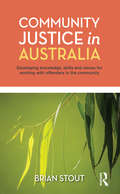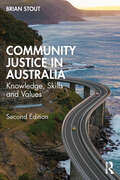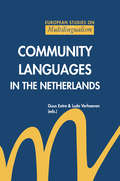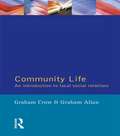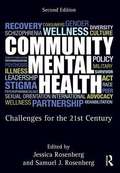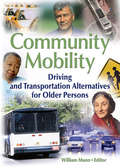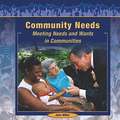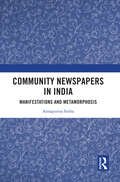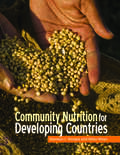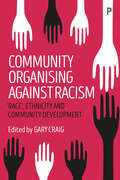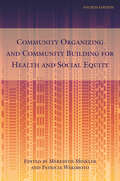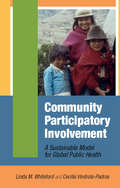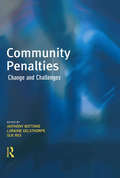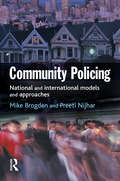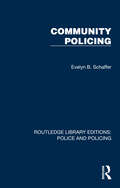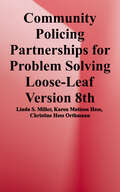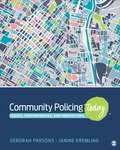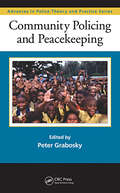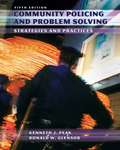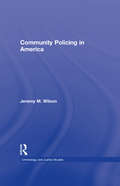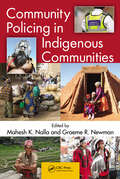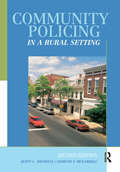- Table View
- List View
Community Justice in Australia: Developing knowledge, skills and values for working with offenders in the community
by Brian Stout'An effective interweaving of complex theory with mainstream concepts. Overall an excellent book for use in Australian universities teaching criminology/social work.' Dr Jane Bolitho, Lecturer, Criminology and Social Sciences, UNSWThe concept of community justice - of engaging with offenders within the community - offers an important new approach to the prevention of crime and the rehabilitation of offenders. Community Justice in Australia is the first text to consider how this concept can be successfully applied within Australia by social workers, criminologists, parole officers, police and anyone working with both adult and youth offenders.Brian Stout begins by defining community justice and outlining its successes in the United Kingdom and the United States. He then explains theories of offending behaviour, considers relevant Australian legislation, policy and common intervention strategies, and considers the implications of community justice approaches for both adult and juvenile offenders. Restorative justice is also examined and contrasted.The book's second half details practice issues including working in community justice organisations, the use of technology, and the need for community justice workers to co-create long-term change with their clients. The importance of risk management and protection of the public is explored together with a comprehensive guide to practice skills and working with involuntary clients. Each chapter also contains a detailed analysis of the implications and potential benefits of a community justice approach for culturally diverse groups and Indigenous people.
Community Justice in Australia: Knowledge, Skills and Values
by Brian StoutThis new edition of Community Justice in Australia expands on the discussion of how people who have committed offences can be engaged in the community. It considers how the concept of community justice can be successfully applied within Australia by social workers, criminologists, parole officers and anyone working in the community with both adults and young people. The book defines community justice and applies the concept to the Australian context. It then explains theories of offending behaviour, considers relevant Australian legislation, policy and intervention strategies and examines the implications for both young people and adults. Restorative justice is also discussed. The latter part of the book focuses on practical issues including working in community justice organisations, technology, public protection and desistance approaches. Each chapter contains an engagement with the implications of community justice approaches for Indigenous groups and features reflective questions, practical tasks and guidance for further reading. This accessible and practical book will be indispensable for instructors, students and practitioners working in the community with people who have committed offences.
Community Languages in the Netherlands
by Guus Extra & Ludo VerhoevenThis book focuses on the international and educational context of ethnic communities and their language varieties in the Netherlands. It presents major trends in Dutch research on community languages and cross-cultural evidence on reported vs observed use of community languages at Dutch schools.
Community Life
by Graham Crow Graham AllanFirst published in 1994. Routledge is an imprint of Taylor & Francis, an informa company.
Community Mental Health
by Jessica Rosenberg Samuel RosenbergThe first edition of Community Mental Health quickly established itself as one of the most comprehensive and timely books about mental health practice in community settings. Readers will find that this new edition is also on the leading edge of the field, providing the most up-to-date research and treatment models in the field. Experts from a wide range of professions - social work, nursing, psychology, psychiatry, public health, sociology, and law - explore the major trends, best practices, and policy issues shaping community mental health services today. Coverage of each topic shifts the focus from management to recovery in the treatment of chronically mentally ill patients. Coverage of organizational and policy issues gives students a head start on mastering the overarching factors that shape their field. This book offers the greatest breadth of coverage available, including hot-button topics like the following: evidence-based treatments neuropsychiatric perspectives Diversity Substance abuse New chapters cover a variety of special populations, which ensures students are prepared to work with a wide range of issues, including: returning veterans military families and families of the mentally ill people affected by the "Great Recession" teenagers children the homeless Students preparing to become mental health professionals, practitioners in community mental health settings, and policy planners and advocates engaged in the evaluation and development of programs in the human services will find this text to be an invaluable resource in their training and work. A collection of supplemental resources are available online to benefit both instructors and students. Instructors will find PowerPoint slides and test banks to aid in conducting their courses, and students can access a library of helpful learning activities, suggested readings and resources, and a glossary of important terms. These materials can be accessed at http://www.routledgementalhealth.com/cw/rosenberg.
Community Mobility: Driving and Transportation Alternatives for Older Persons
by William C. MannAffordable, easy-to-use, and flexible transportation options are vital to older adults' quality of life. Community Mobility: Driving and Transportation Alternatives for Older Persons provides physical and occupational therapists with recent research findings on older driver assessment, remediation/rehabilitation, and the use of alternatives to the car in the event that older adults need to "retire" from driving. This unique book addresses changes in driving patterns over time, the impact of climate conditions on driving, mental and physical health issues, self-regulation by drivers, and driver safety. Community Mobility addresses changes in driving patterns over time, the impact of climate conditions on driving, mental and physical health issues, self-regulation by drivers, and driver safety. This unique book also includes summaries of recent consensus conferences held in the United States and Canada to determine the best approaches to therapist services and counseling. Community Mobility examines: the effect of alternative forms of transportation on drivers in declining mental and physical health safety interventions the relationship between chronic illness and an elderly driver&’s "home range" road conditions versus driving patterns factors that can act as predictors in mobility patterns self-regulation and adaptation strategies effective remediation techniques a comprehensive driving evaluation (CDE) and much more!Community Mobility is an essential resource for anyone working with elderly drivers who face the loss of independence and the decreased access to social activities, medical services, and other basic needs that accompany "retirement" from the driver&’s seat.
Community Needs: Meeting Needs And Wants In Communities (Communities At Work)
by Jake MillerThis engaging, age-appropriate set is designed to meet the early childhood social studies curriculum, where students learn about themselves and their community and what makes their community similar to and different from communities across the United States. By taking a kid-friendly Who's Who approach to different kinds of communities, these books teach students about the people who work to make each community a success. There are things that people need to survive and things that they want to make life enjoyable. This book explains the difference and shows how needs and wants may be met. From food, clothing, and shelter to museums, police officers, and swimming pools, kids will learn how people in communities work to make sure that everybody gets a share of what they need and want.
Community Newspapers in India: Manifestation and Metamorphosis
by Annapurna SinhaThis book provides a comprehensive account of community newspapers in India discussing their reach, practices, management and influence on communities. It focuses on the core characteristics associated with community media, such as access and participation, advocacy and self-management among other. With the help of detailed case studies of two established newspapers – Khabar Lahariya and Namaskar, the book highlights the unique aspects of their rhizomatic expansion and the practices for social change. By examining their manifestations and metamorphosis, the book shows how community media is fluid and evolves with time owing to diverse motivations. The author also examines themes such as media democracy and citizens engagement; role of alternative media and the diversity of practices and profiles to highlight the relevance, identity and purpose of alternative media in general and community newspapers in particular. This book will be of interest to scholars and researchers of media studies, journalism and mass communication, political studies, development studies, law and South Asian studies. It will also be useful to NGOs and CSOs working in the areas of community engagement, social development and empowerment, and literacy.
Community Nutrition Resilience in Greater Miami: Feeding Communities in the Face of Climate Change (Palgrave Studies in Climate Resilient Societies)
by Franziska Alesso-BendischThis book conceptualizes community nutrition resilience as a critical area that is currently lacking the attention it requires from both the public and private sectors. The book spotlights Greater Miami’s resilience efforts, both responding to slowly developing challenges such as immigration, environmental deterioration, and the wealth distribution gap, as well as sudden disasters such as hurricanes or flooding driven by climate change. Drawing on existing literature as well as interviews with professionals working in the field, the author makes recommendations on how to incorporate food systems into urban resilience planning, how to prioritize resilience on urban food agendas, and how to strengthen food system resilience through public, private, and third sector level engagement. She also highlights how the availability of and access to nutritious food impact the health, performance, and well-being of communities in the region, thus making a strong case for the prioritization of this growing issue.
Community Nutrition for Developing Countries
by Norman J. Temple Nelia SteynA co-publication with UNISA Press Nutrition textbooks used by universities and colleges in developing countries have very often been written by scholars who live and work in North America or the United Kingdom. And while the research and information they present is sound, the nutrition-related health challenges with which developing countries must grapple differ considerably from those found in highly industrialized Western nations. The primary aim of Community Nutrition for Developing Countries is to provide a book that meets the needs of nutritionists and other health professionals living and working in developing countries. Written by both scholars and practitioners, the volume draws on their wealth of knowledge, experience, and understanding of nutrition in developing countries to provide nutrition professionals with all the information they require. Each chapter addresses a specific nutrition challenge currently faced by developing countries such as food security, food safety, disease prevention, maternal health, and effective nutrition policy. In addition, the volume serves as an invaluable resource for those developing and implementing nutrition education programmes. With an emphasis on nutritional education as a means to prevent disease and effectively manage health disorders, it is the hope of the nearly three dozen contributors to this work that it will enhance the health and well-being of low-income populations throughout the world.
Community Organising against Racism: 'Race', Ethnicity and Community Development
by Gary CraigIn this unique global collection, Gary Craig and his contributors blend theory and practice-based case studies to review how different community development approaches can empower minority ethnic communities to confront racism and overcome social, economic and political disadvantage. The book explores key questions about the empowerment and capacity-building of minority ethnic groups. Using case studies from across the ‘developed’ world, and in differing social and economic contexts, contributors explore these issues in working with asylum-seeker communities, addressing tensions between minorities and building alliances, in work with Gypsy, Roma and Traveller communities, and using arts-based approaches. The book will stimulate wider debates about the role of community development in relation to ‘race’ and ethnicity at a time when ‘race’ is being ‘invisibilised’ in public policy, and will be an invaluable resource for policy-makers, politicians, academics, and students from many disciplines.
Community Organizing and Community Building for Health and Social Equity, 4th edition
by Barack Obama Stephen B. Thomas Rinku Sen John P. Kretzmann Rachel Morello-Frosch Meredith Minkler Nina Wallerstein Barbara A. Israel Eugenia Eng Edith A. Parker Tom Wolff Celina Su Manuel Pastor Jason Corburn Whitney Johnson Ronald Labonté Mark S. Homan Christine Mitchell Michelle C. Kegler Patricia Wakimoto Lionel J. Beaulieu Adam B. Becker Lynn Blanchard Anne Bluethenthal Frances Dunn Butterfross Lisa Cacari Stone Caricia Catalani Charlotte Yu-Ting Chang Roxana Chen Wayland X. Coleman Chris M. Coombe Lori Dorfman Nancy Epstein Jessica Estrada Jennifer Falbe Stephanie A. Farquhar Prisila Gonzalez Joseph Griffin Leslie Grover Lorraine Gutiérrez Trevor Hancock Susana Hennesey Laverty Reva Hines Lili Farhang Solange Gould Cheryl A. Hyde Anthony B. Iton Josh Kirschenbaum Blishda Lacet Pam Tau Lee Edith A. Lewis Jennifer Lifshay Laura Linnan Shaw San Liu Shaddai Martinez Cuestas Marty Martinson John L. McKnight Mary Anne Morgan Angela Ni Susan Racine Passmore Amber Akemi Piatt Cheri A. Pies Clara Pinsky R. David Rebanal Kathleen M. Roe Zachary Rowe Alicia L. Salvatore Shannon Sanchez-Youngman Amy J. Shulz Lee Staples Makani Themba Maria Elena Torre Evan Vandommelen-Gonzalez Dierde Visser Kirsten Wysen Marisa Ruiz Asari Nickie Bazell Derek M Griffith Heather CameThe fourth edition of Community Organizing and Community Building for Health and Social Equity provides both classic and recent contributions to the field, with a special accent on how these approaches can contribute to health and social equity. The 23 chapters offer conceptual frameworks, skill- building and case studies in areas like coalition building, organizing by and with women of color, community assessment, and the power of the arts, the Internet, social media, and policy and media advocacy in such work. The use of participatory evaluation and strategies and tips on fundraising for community organizing also are presented, as are the ethical challenges that can arise in this work, and helpful tools for anticipating and addressing them. Also included are study questions for use in the classroom. Many of the book’s contributors are leaders in their academic fields, from public health and social work, to community psychology and urban and regional planning, and to social and political science. One author was the 44th president of the United States, himself a former community organizer in Chicago, who reflects on his earlier vocation and its importance. Other contributors are inspiring community leaders whose work on-the-ground and in partnership with us “outsiders” highlights both the power of collaboration, and the cultural humility and other skills required to do it well. Throughout this book, and particularly in the case studies and examples shared, the role of context is critical, and never far from view. Included here most recently are the horrific and continuing toll of the COVID-19 pandemic, and a long overdue, yet still greatly circumscribed, “national reckoning with systemic racism,” in the aftermath of the brutal police killing of yet another unarmed Black person, and then another and another, seemingly without end. In many chapters, the authors highlight different facets of the Black Lives Matter movement that took on new life across the country and the world in response to these atrocities. In other chapters, the existential threat of climate change and grave threats to democracy also are underscored.
Community Participatory Involvement: A Sustainable Model for Global Public Health
by Cecilia Vindrola-Padros Linda M WhitefordThe book provides researchers, students, and practitioners in public health, anthropology, and related fields with a brief introduction to a health-care model, Community Participatory Involvement (CPI), which for 20 years has proved successful in fighting global health problems. CPI differs from other community-based models in that it involves a unique synergy of local, civil, and political authorities. Using a South American cholera epidemic as an example, the book -explains in step-by-step detail how the CPI model is used;-includes teaching activities, a list of important tools, and model workshops;-demonstrates how the CPI model can be replicated to deal with a diverse range of public concerns, from the control of infectious diseases to animal husbandry to teacher education.
Community Penalties
by Anthony Bottoms Loraine Gelsthorpe Sue RexCommunity penalties are punishments that, in the courts' sentencing tariff, come between imprisonment and fines. They include electronic tagging, supervised unpaid work, and compulsory participation by offenders in treatment programmes.Recent years have seen many changes in England in the field of community penalties. These have included the rapid development of accredited offending behaviour programmes, and some new court orders such as the Referral Order for juveniles, based on the principles of restorative justice. Organisationally, too, the year 2001 sees a major change with the establishment of the National Probation Service for England and Wales.Community Penalties: change and challenges addresses the key issues facing community penalties at this critical time. Topics covered include the recent history of community penalties, partnership work, cognitive behavioural approaches to changing offenders' behaviour (and the need to look beyond these), compliance theory, accountability to the public and to the victim, accommodating difference and diversity in the delivery of community penalties, the use of technology in community penalties, and community penalties and issues of public safety.Community Penalties: change and challenges brings together many leading authors in this field. Together, they provide an authoritative review of a vital field of public policy.
Community Policing
by Mike Brogden Preeti NijharCommunity policing has been a buzzword in Anglo-American policing for the last two decades, somewhat vague in its definition but generally considered to be a good thing. In the UK the notion of community policing conveys a consensual policing style, offering an alternative to past public order and crimefighting styles. In the US community policing represents the dominant ideology of policing as reflected in a myriad of urban schemes and funding practices, the new orthodoxy in North American policing policy-making, strategies and tactic. But it has also become a massive export to non-western societies where it has been adopted in many countries, in the face of scant evidence of its appropriateness in very different contexts and surroundings. critical analysis of concept of community policing worldwide assesses evidence for its effectiveness, especially in the USA and UK highlights often inappropriate export of community policing models to failed and transitional societies.
Community Policing (Routledge Library Editions: Police and Policing)
by Evelyn B. SchafferOriginally published in 1980, Community Policing is a view of the relationship between the police and the community, written by Evelyn B. Schaffer, an outsider who had worked very closely with the police. It covers many Forces and projects, particularly in Scotland who pioneered community policing. It explores the various means that police forces were using to get closer to the community at the time, including work with schools and specialist work with juveniles and their families. It also includes a chapter on police training and its effect on community policing.
Community Policing Partnerships for Problem Solving
by Christine Hess Orthmann Linda S. Miller Karen Matison HessWith a strong focus on problem solving and community-police partnerships, this comprehensive text provides a practical, up-to-date guide to effective community policing. <p><p>After an introduction to the history and philosophy of the movement that has profoundly shaped modern police operations, the authors emphasize practical strategies and essential skills to help readers apply effective, real-world problem solving within their communities. <p><p>In light of recent high-profile deadly force incidents that have strained the relationships between the community and the police, the eighth edition taps into the recommendations in the Final Report of the President's Task Force on 21st Century Policing and its call for a renewed emphasis on community policing to strengthen public trust and build police legitimacy. <p><p>And the MindTap that accompanies this text helps you master techniques and key concepts while engaging you with career-based decision-making scenarios, visual summaries, and more.
Community Policing Today: Issues, Controversies, and Innovations
by Deborah A. Parsons Janine KremlingWritten by an author team with experience in law enforcement and in the classroom, Community Policing Today explores the strategies police and communities can use to find long-term solutions to the public safety issues facing today’s communities, including gangs, high crime, and disproportionate minority contact. Framing community policing not as a program, but as a transformation from traditional policing that involves sweeping changes in the way police view their role and relationships with the community, the authors demonstrate how law enforcement officers can partner with the community to help facilitate problem-solving of public safety issues. With an emphasis on cutting-edge trends and impacts on community policing, this book offers students a better understanding of the complexity and promise of community policing today. Included with this title: The password-protected Instructor Resource Site (formally known as SAGE Edge) offers access to all text-specific resources, including a test bank and editable, chapter-specific PowerPoint® slides.
Community Policing Today: Issues, Controversies, and Innovations
by Deborah A. Parsons Janine KremlingWritten by an author team with experience in law enforcement and in the classroom, Community Policing Today explores the strategies police and communities can use to find long-term solutions to the public safety issues facing today’s communities, including gangs, high crime, and disproportionate minority contact. Framing community policing not as a program, but as a transformation from traditional policing that involves sweeping changes in the way police view their role and relationships with the community, the authors demonstrate how law enforcement officers can partner with the community to help facilitate problem-solving of public safety issues. With an emphasis on cutting-edge trends and impacts on community policing, this book offers students a better understanding of the complexity and promise of community policing today. Included with this title: The password-protected Instructor Resource Site (formally known as SAGE Edge) offers access to all text-specific resources, including a test bank and editable, chapter-specific PowerPoint® slides.
Community Policing and Peacekeeping (Advances in Police Theory and Practice)
by Peter GraboskyIn modern industrial societies, the demand for policing services frequently exceeds the current and foreseeable availability of public policing resources. Conversely, developing nations often suffer from an inability to provide a basic level of security for their citizens. Community Policing and Peacekeeping offers a fresh overview of the challenge
Community Policing and Problem Solving: Strategies and Practices (5th edition)
by Kenneth J. Peak Ronald W. GlensorThis book is about policing at its most important and challenging levels--in neighborhoods and in communities across the nation and abroad. Unique in perspective, its focus is on community policing and problem solving-and the processes that are being implemented under COPPS to control and prevent crime, disorder and fear. Extremely applied, this book focuses on daily processes and tactics and how and why agencies are revolutionizing their traditional philosophy and operations. This fifth edition provides updated information on crime in the United States, more emphasis on terrorism and homeland defense, and a new chapter on information technology. Authoritative and practical perspective combines the classroom expertise of a seasoned criminal justice educator with the practical experience of an executive-level police administrator. Community-oriented policing and problem solving (COPPS) focus provides a comprehensive view of how agencies are changing their management style, organizational structures, and operational strategies to attack crime, disorder and fear. Includes topics such as computer-aided dispatch, mobile computing, records management, geomapping, CompStat, global positioning systems, use of the Internet, and surveys. Police practictioners with a fundamental knowledge of police history or operations or those working in a government agency outside policing and are interested in learning about community policing and problem solving.
Community Policing in America (Criminology and Justice Studies)
by Jeremy M. WilsonAlthough law enforcement officials have long recognized the need to cooperate with the communities they serve, recent efforts to enhance performance and maximize resources have resulted in a more strategic approach to collaboration among police, local governments, and community members. The goal of these so-called "community policing" initiatives is to prevent neighborhood crime, reduce the fear of crime, and enhance the quality of life in communities. Despite the growing national interest in and support for community policing, the factors that influence an effective implementation have been largely unexplored. Drawing on data from nearly every major U.S. municipal police force, Community Policing in America is the first comprehensive study to examine how the organizational context and structure of police organizations impact the implementation of community policing. Jeremy Wilson’s book offers a unique theoretical framework within which to consider community policing, and identifies key internal and external factors that can facilitate or impede this process, including community characteristics, geographical region, police chief turnover, and structural complexity and control. It also provides a simple tool that practitioners, policymakers, and researchers can use to measure community policing in specific police organizations.
Community Policing in Indigenous Communities
by Mahesh K. Nalla Graeme R. NewmanIndigenous communities are typically those that challenge the laws of the nation states of which they have become often very reluctantly a part. Around the world, community policing has emerged in many of these regions as a product of their physical environments and cultures. Through a series of case studies, Community Policing in Indigenous Commun
Community Policing in a Rural Setting (2nd Edition)
by Quint Thurman Edmund F. McGarrellThe authors provide stepping stones for rural and small-town agencies to make the organizational changes needed for community policing to take hold. The book introduces the concept of community policing and its many benefits to the agencies and communities that adopt it. Important issues discussed include the challenge of organizational change, as well as examples of community policing obstacles and successes, and the future of community policing in the 21st century.
Community Policing, 3rd Edition
by Victor E. Kappeler Robert Trojanowic Larry K. GainesWe have attempted to extend the road map that the father of community policing sketched and bring it back into contemporary focus.
